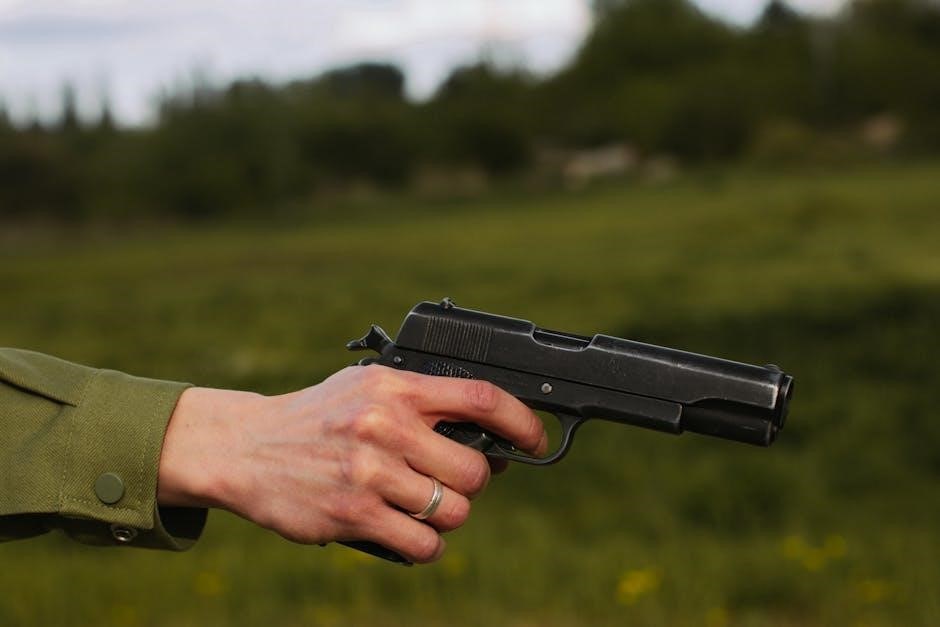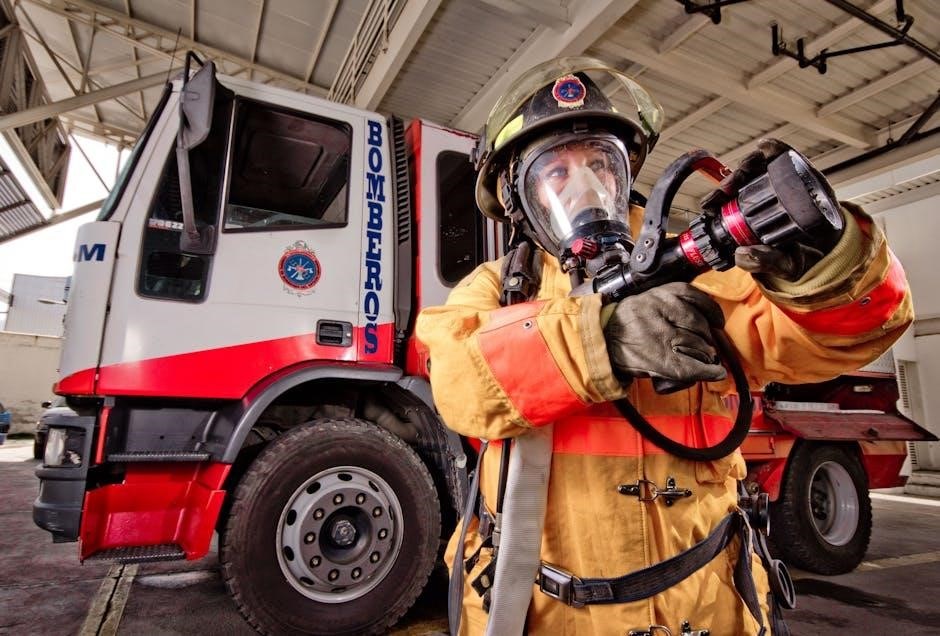Welcome to the First Alert Smoke Detector Owner’s Manual․ This guide provides essential information for installing‚ maintaining‚ and operating your smoke detector to ensure fire safety․ Read carefully for optimal performance and compliance with safety standards․
1․1 Purpose of the Manual
This manual is designed to guide users in understanding and properly utilizing their First Alert Smoke Detector․ It provides detailed instructions for installation‚ maintenance‚ and operation‚ ensuring optimal performance and compliance with safety standards like UL 217․ The manual covers essential features‚ troubleshooting‚ and safety precautions to help users ensure reliable fire detection․ By following the guidelines‚ users can maximize the effectiveness of their smoke detector‚ contributing to a safer living environment․ This document is a crucial resource for both self-installation and professional setup‚ guaranteeing all necessary information is readily available for user convenience and safety․
1․2 Important Safety Information
Adhering to the safety guidelines in this manual is crucial for optimal performance and reliability of your First Alert Smoke Detector․ Never remove batteries to silence unwanted alarms; instead‚ open windows or fan smoke away․ The detector is designed to sense combustion particles‚ not gas or heat․ Failure to follow installation and maintenance instructions may reduce effectiveness․ Regular testing and maintenance ensure proper functionality․ Keep this manual accessible for future reference; Compliance with UL 217 standards guarantees reliability‚ but user adherence to safety precautions is essential for effective fire detection and alarm response․ Always prioritize safety when handling your smoke detector․

Installation Guidelines for First Alert Smoke Detectors
Proper installation is critical for reliable performance․ Place detectors 6-12 inches below the ceiling‚ avoiding kitchens and bathrooms․ Ensure all units interconnect in multi-unit homes and follow local building codes for optimal safety and compliance․
2․1 Choosing the Correct Location for Smoke Detectors
For optimal performance‚ install smoke detectors in every bedroom‚ outside sleeping areas‚ and on each level of your home․ Avoid placing them near kitchens‚ bathrooms‚ windows‚ or doors to minimize false alarms from cooking smoke or steam․ Position detectors 6-12 inches below the ceiling‚ away from walls and corners‚ to ensure accurate smoke detection․ Interconnecting units in multi-level homes enhances safety‚ as all alarms will sound if one detects smoke․ Proper placement ensures reliable fire detection and early warning‚ crucial for safe evacuation․
2․2 Step-by-Step Installation Instructions
Begin by turning off power at the circuit breaker for hardwired models․ Mount the bracket to the wall or ceiling using screws․ Attach the smoke detector to the bracket by twisting it clockwise․ Insert the 9-volt battery‚ ensuring proper polarity․ Restore power and test the alarm by pressing the test button until it beeps․ For interconnected systems‚ ensure all units are linked to sound simultaneously․ Refer to the manual for specific wiring instructions․ Secure all connections and double-check functionality to ensure reliable fire detection and alerting․ Proper installation is critical for safety and compliance with UL standards․

Understanding Your First Alert Smoke Detector Components
This section explains the smoke detector’s key components‚ including the ionization sensor‚ test button‚ and LED indicator․ Understanding these parts ensures proper functionality and maintenance․
3;1 Key Features of the First Alert Smoke Detector
The First Alert Smoke Detector features advanced ionization sensors for rapid smoke detection‚ a test button for functionality checks‚ and an LED indicator for status updates․ It includes a battery backup system for continuous protection during power outages․ The silence button allows users to temporarily mute false alarms caused by cooking smoke․ Designed for reliability‚ it meets UL217 standards‚ ensuring compliance with fire safety regulations․ These features combined provide a comprehensive solution for early fire detection‚ enhancing home safety and peace of mind․
3․2 Identifying the Smoke Detector’s Sensors and Indicators
The First Alert Smoke Detector features an ionization sensor that detects smoke particles in the air․ The LED indicator flashes to signal normal operation‚ while continuous flashing indicates an alarm condition․ The test button doubles as a silence feature‚ allowing users to check functionality or mute false alarms․ The sensor chamber is designed to capture smoke particles accurately‚ ensuring reliable detection․ Indicators provide visual confirmation of the detector’s status‚ ensuring users can identify normal operation‚ alarms‚ or troubleshooting needs․ Understanding these components is crucial for maintaining and operating the detector effectively․
Maintenance and Troubleshooting Tips
Regularly clean the smoke detector to ensure optimal performance․ Check sensors for dust and debris․ Replace batteries annually or when the low-battery chirp sounds․ Troubleshoot false alarms by checking for cooking smoke or steam interference․ Reset the unit by opening windows or fanning smoke away․ Address continuous beeping after battery replacement by ensuring proper installation and connections․ Refer to the manual for detailed solutions to common issues․
4․1 Cleaning the Smoke Detector
Regular cleaning is crucial for maintaining your smoke detector’s performance․ Use a vacuum cleaner or a soft brush to gently remove dust and debris from the exterior and interior․ Dampen a cloth with water and wipe the unit‚ avoiding chemicals or harsh cleaners that may damage sensors․ Ensure the detector is turned off before cleaning․ For stubborn particles‚ use compressed air carefully․ Cleaning helps prevent false alarms caused by dust buildup․ Perform this maintenance every 30 days or as needed to ensure reliable fire detection and optimal functionality․
4․2 Replacing Batteries and Ensuring Proper Functionality
To maintain your smoke detector’s reliability‚ replace the 9-volt battery annually or when the low-battery warning chirps․ Turn off the alarm before replacing the battery to avoid false signals; Open the battery compartment‚ remove the old battery‚ and insert a new one‚ ensuring correct polarity․ After replacing‚ test the detector by pressing the test button to confirm proper functionality․ Never remove batteries to silence a nuisance alarm; instead‚ open windows or fan away smoke․ A functional battery ensures continuous protection and prevents potential risks from undetected fires․
4․3 Common Issues and Solutions
Common issues with your First Alert smoke detector include continuous beeping‚ nuisance alarms‚ and sensor malfunctions․ For continuous beeping‚ ensure the battery is fresh and properly installed․ Nuisance alarms caused by cooking smoke can be resolved by opening windows or using the silence feature․ If the detector is not functioning‚ check for dust or debris and clean the sensor․ If issues persist‚ refer to the troubleshooting guide or contact customer support․ Regular maintenance and proper installation are key to ensuring reliable performance and accurate smoke detection․

Operating the First Alert Smoke Detector
The First Alert smoke detector alarms when smoke is detected․ Avoid removing batteries to stop nuisance alarms; instead‚ open windows or fan smoke away․ The alarm resets automatically when smoke clears․ Regular cleaning ensures optimal performance․
5․1 Testing the Smoke Detector
Test your First Alert smoke detector monthly to ensure proper function․ Press and hold the test button until the alarm sounds․ A loud‚ continuous beep confirms it’s working․ If no sound occurs‚ check for battery issues or interference․ For hardwired models‚ test after power restoration․ Use a smoke source like a candle (carefully) to verify detection․ If the alarm doesn’t trigger‚ inspect for dust or obstructions․ Regular testing ensures your detector is ready to alert you in case of fire; Failure to test may reduce its effectiveness in an emergency‚ risking safety․ Always follow manual guidelines for accurate results․
5․2 Understanding Alarm Signals and Silence Features
Your First Alert smoke detector emits a continuous beep when smoke is detected․ A single chirp every 30 seconds indicates a low battery․ The silence feature temporarily mutes nuisance alarms‚ like those caused by cooking smoke․ Press the test/silence button to activate this mode․ The alarm will automatically reset once the air clears․ Never remove batteries to silence an unwanted alarm‚ as this disables protection․ Understanding these signals ensures proper functionality and safety․ Always refer to the manual for detailed guidance on alarm behavior and silence operations to maintain optimal fire protection․
Technical Specifications and Compliance
This First Alert smoke detector complies with UL 217 standards‚ utilizing ionization sensing technology to detect combustion particles․ It operates on AC power with battery backup‚ featuring silence and latching features for enhanced safety and troubleshooting․
6․1 Regulatory Compliance (UL 217 Standards)
All First Alert smoke detectors meet UL 217 standards‚ ensuring reliable fire detection․ These standards require detectors to identify smoke particles from various combustion sources․ Compliance ensures they function effectively in different environments‚ providing consistent protection․ Adherence to UL 217 guarantees that the devices meet rigorous safety and performance criteria‚ offering users peace of mind․ Proper installation and maintenance are crucial to maintaining compliance and ensuring the detectors operate as intended․ Always follow guidelines to uphold safety standards and device functionality․
6․2 Sensitivity and Detection Capabilities
First Alert smoke detectors are engineered with advanced sensing technology to detect smoke particles quickly and accurately․ Their sensitivity ensures early warning‚ crucial for fire safety․ Designed to identify various smoke types‚ including fast-flaming and smoldering fires‚ these detectors provide reliable protection․ Features like ionization sensors enable them to detect even small particles‚ enhancing their effectiveness․ Regular testing ensures optimal performance‚ maintaining their ability to alert users promptly․ This sensitivity is vital for safeguarding lives and property‚ making them a trusted choice for home fire safety systems․

User Resources and Support
Access the full PDF manual online for detailed guidance․ Contact First Alert Customer Support at 1-800-323-9005 for assistance․ Manuals are available for 21 models‚ ensuring comprehensive support․
7․1 Accessing the Full PDF Manual Online
The full PDF manual for your First Alert Smoke Detector is available online for easy access․ Visit the official First Alert website or authorized platforms to download the manual․ Popular models like the 9120 and 9120B are readily available․ Ensure you select the correct model number for accurate instructions․ If you need a hard copy‚ request a replacement manual for a small fee by contacting customer support․ This resource provides detailed guidance for installation‚ operation‚ and troubleshooting‚ ensuring you get the most out of your smoke detector․
7․2 Contacting First Alert Customer Support
For assistance with your First Alert Smoke Detector‚ contact customer support at 1-800-323-9005․ Representatives are available to help with troubleshooting‚ product inquiries‚ and replacement manuals․ Visit the official First Alert website for additional resources and support options․ When reaching out‚ have your model number ready to ensure accurate assistance․ This service is designed to provide comprehensive support for optimal use of your smoke detector․
